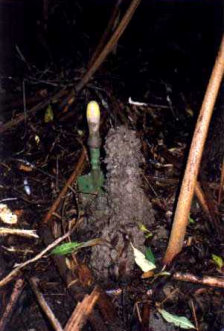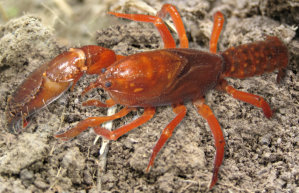Threatened Burrowing Crayfish of
West Gippsland
Web Site by VP-IT
All photographs © Dr. Beverley Van Praagh, Invert-Eco unless otherwise stated. No image may be saved, copied, reproduced or distributed without prior permission from the copyright owner.
Strzelecki Burrowing Crayfish
The Strzelecki Burrowing Crayfish is found over an area of approximately 30 x 30 kms in the high altitude areas above 400 m in the eastern Strzelecki Ranges (click here for map of range).What do Strzelecki Burrowing Crayfish Look Like?
Size: Adults have a carapace (back shield) length of around 24-30 mm with a total length of around 60 mm. Colour: Range in colour from dark purple and olive hues through to bright orange and red, generally with bright orange or red legs. Others exhibit lighter, yellow hues. Claws may be same size (isomorphic) or different size and shape (dimorphic), often with orange grading to olive and blue with bright orange tips. Distinguishing Features: The distinguishing feature of this crayfish is it’s rostrum (anterior projection of head) which is: tuberculate (lumpy), ends in a blunt tip, and projects downwards Habitat: Strzelecki Burrowing Crayfish are found in similar habitats to the Narracan Burrowing Crayfish. While their ranges do not overlap, they are found adjacent to each other. Strzelecki Burrowing Crayfish can be found in heavy clay or clay loam soils along creek banks, flood-beds and boggy seepage areas. They are more likely to be found along the smaller tributaries or expanded seepage areas away from the main waterway. Their main habitat is Wet Forest. The species can also be found in Cool Temperate Forest at Tarra-Bulga National Park. Burrows & Chimney’s: Burrow structure is very similar to the Narracan Burrowing Crayfish. Burrows may be quite shallow, especially in seepage or flood-bed areas, and may be found under the roots of tree ferns. Other burrows are more vertical with lateral ramifications, often further descending into a water-filled or muddy chamber at around 30 cm. The crayfish often reside in these chambers. Burrows may consist of two or more (up to 8 have been recorded) entrances (> 2.5 cm) surrounded by tall, pelleted chimneys up to 10 cm in height. Chimneys may also be indistinct, rim or fan shaped and only 1-2 cm high.
Click image to enlarge
Click image to enlarge



Click image to enlarge
Streamside Habitat

Further information:
Fact Sheet: Strzelecki Burrowing Crayfish - Recognising & Protecting Crayfish Habitat West Gippsland Burrowing Crayfish

Click image to enlarge
Ferny Gully Habitat

Click image to enlarge
Strzelecki Burrowing Crayfish
Chimney
Click image to enlarge
Boggy Seepage Habitat
Click image to enlarge
Strzelecki Burrowing Crayfish
Chimney


Photo: R. Appleton
















